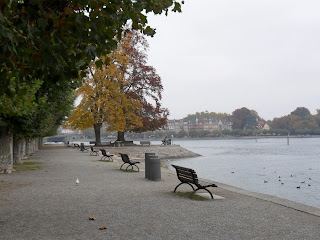This Saturday a group of us decided to make the short train ride over to Liechtenstein. None of us had ever been there before and I was simply curious of how a country smaller than half the canton of Zurich actually looks. It turns out: quite beautiful – we were pretty happy to have the combination of Autumn and sunny weather.
The flag of the Principality of Liechtenstein. Curiously their national anthem shares the same melody as the British national anthem.
We arrived in Buchs (Switzerland) and made the short walk over the border into Liechtenstein, where we then headed to Vaduz – the capital city – or perhaps more fittingly: the capital village as there are only around 35,000 people in the whole of the country! First impressions were pretty good, there was lots of modern architecture as well as art and you were never too far away from the rather princely castle, Schloss Vaduz, which sits on a crag overlooking Vaduz.
Many trees and lampposts were wrapped in a knitted coat which looked really cool albeit strange.
Unfortunately we couldn't enter the castle but the view from the top was impressive. So after accepting the fact that the prince and princess were not willing to entertain us, we walked back down into Vaduz where we then took a bus to Schellenberg, a village in the north of the country, home to one of our friends.
Schloss Vaduz is unfortunately closed to the public, but the walk up was worth it simply for the views.
After some great hospitality we accepted an invitation to dinner at a restaurant in Feldkirch, Austria – just a 12 minute drive away despite being in a different country. The Schattenberg wasn't just any restaurant, rather a huge castle sat overlooking the city which specialises in schnitzel. Such a place is always going to be a winner for me, it ticks both boxes: it's a castle, and it serves great schnitzel.
Liechtenstein nestles between Switzerland and Austria. Map image source: BBC
All in all despite being a country small enough to refer to Switzerland as a giant, there was enough to see and do in the country. A great day had in Liechtenstein and also a great evening in Austria – which I will have to revisit soon...














